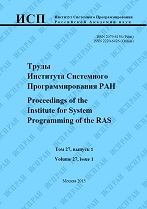|
Program for constructing quite interpretable elementary and non-elementary quasi-linear regression models
M. P. Bazilevskiy
Irkutsk State University of Railway Engineering
Abstract:
A quite interpretable linear regression satisfies the following conditions: the signs of its coefficients correspond to the meaningful meaning of the factors; multicollinearity is negligible; coefficients are significant; the quality of the model approximation is high. Previously, to construct such models, estimated using the ordinary least squares, the QInter-1 program was developed. In it, according to the given initial parameters, the mixed integer 0-1 linear programming task is automatically generated, as a result of which the most informative regressors are selected. The mathematical apparatus underlying this program was significantly expanded over time: non-elementary linear regressions were developed, linear restrictions on the absolute values of intercorrelations were proposed to control multicollinearity, assumptions appeared about the possibility of constructing not only linear, but also quasi-linear regressions. This article is devoted to the description of the developed second version of the program for constructing quite interpretable regressions QInter-2. The QInter-2 program allows, depending on the initial parameters selected by the user, to automatically formulate for the LPSolve solver the mixed integer 0-1 linear programming task for constructing both elementary and non-elementary quite interpretable quasi-linear regressions. It is possible to set up to nine elementary functions and control such parameters as the number of regressors in the model, the number of signs in real numbers after the decimal point, the absolute contributions of variables to the overall determination, the number of occurrences of explanatory variables in the model, and the magnitude of intercorrelations. In the process of working with the program, you can also control the number of elementary and non-elementarily transformed variables that affect the speed of solving the mixed integer 0-1 linear programming task. The QInter-2 program is universal and can be used to construct quite interpretable mathematical dependencies in various subject areas.
Keywords:
linear regression, quite interpretable regression, ordinary least squares, multicollinearity, intercorrelation, quasi-linear regression, non-elementary regression, subset selection in regression, mixed integer 0-1 linear programming, non-linearity criterion
Citation:
M. P. Bazilevskiy, “Program for constructing quite interpretable elementary and non-elementary quasi-linear regression models”, Proceedings of ISP RAS, 35:4 (2023), 129–144
Linking options:
https://www.mathnet.ru/eng/tisp805 https://www.mathnet.ru/eng/tisp/v35/i4/p129
|

| Statistics & downloads: |
| Abstract page: | 40 | | Full-text PDF : | 18 |
|




 Contact us:
Contact us: Terms of Use
Terms of Use
 Registration to the website
Registration to the website Logotypes
Logotypes









 Citation in format
Citation in format 